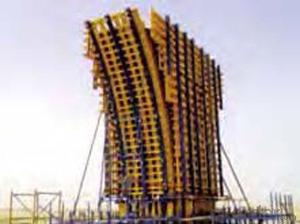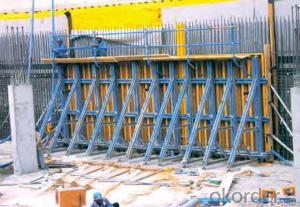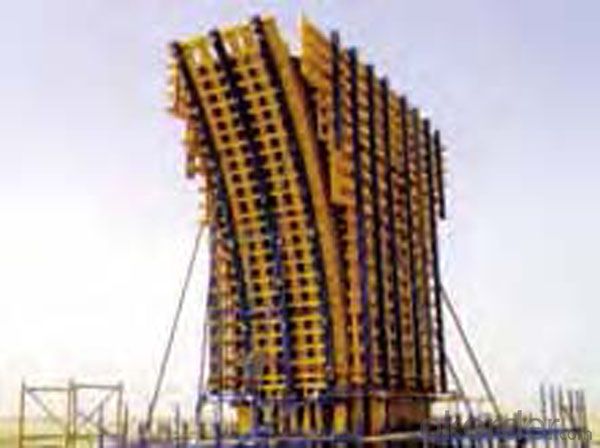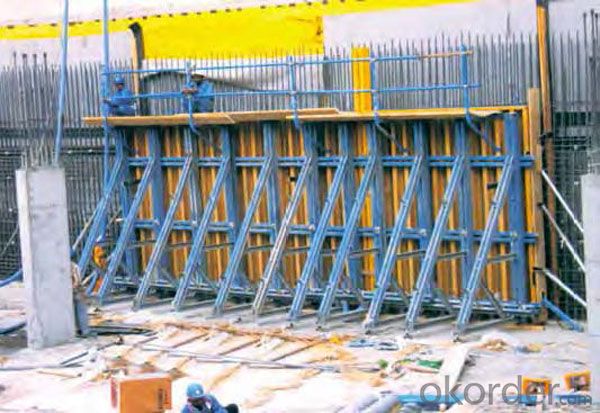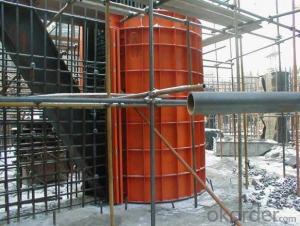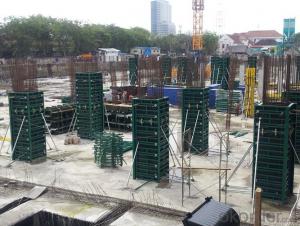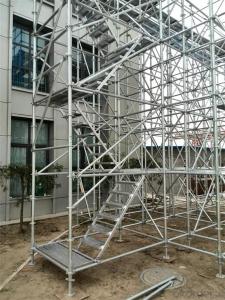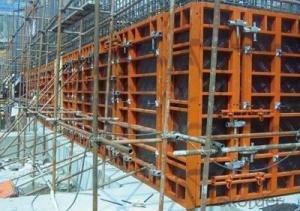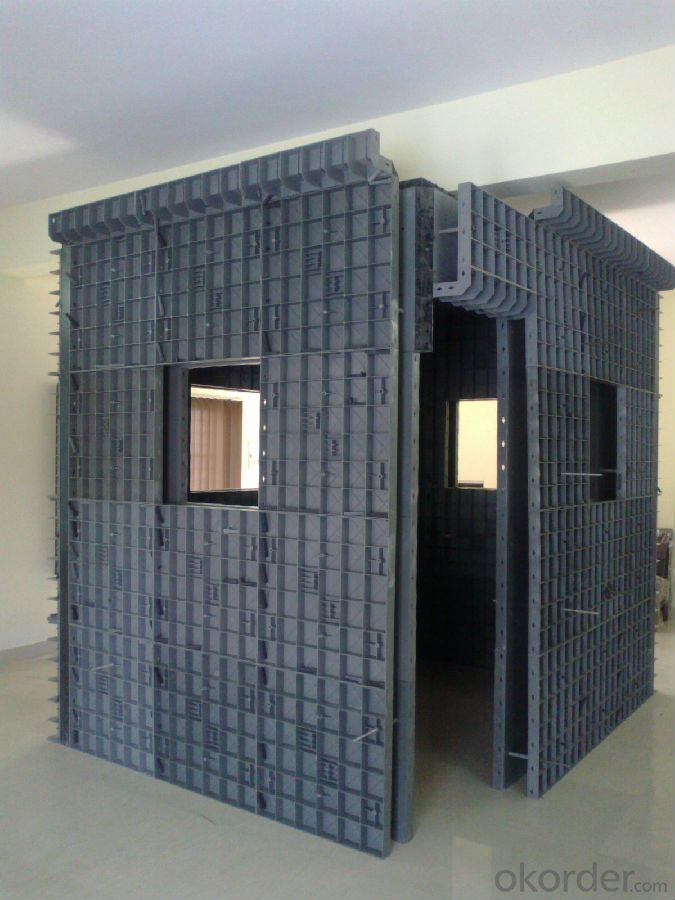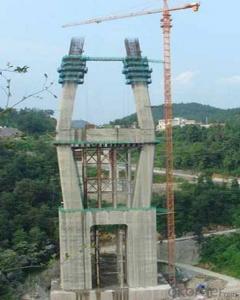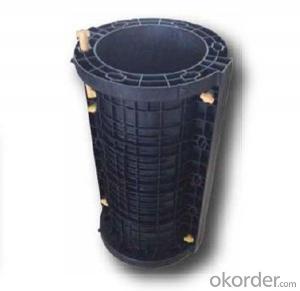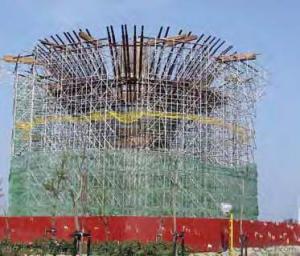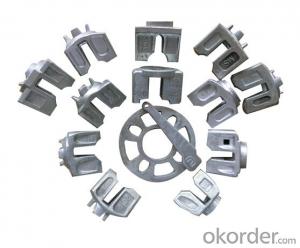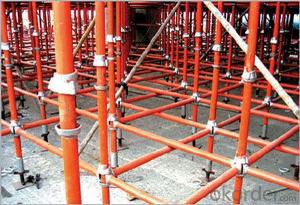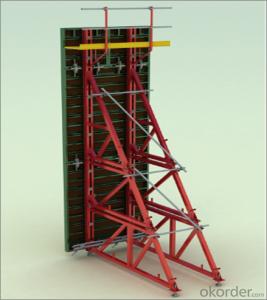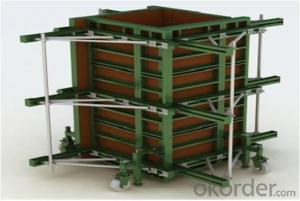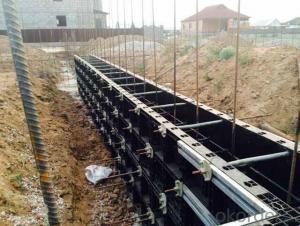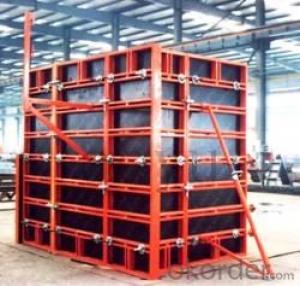All-Round Scaffolding System Formwork Ringlock Scaffolding System Made In China
- Loading Port:
- Tianjin
- Payment Terms:
- TT OR LC
- Min Order Qty:
- 10000 set
- Supply Capability:
- 50000 set/month
OKorder Service Pledge
OKorder Financial Service
You Might Also Like
All-Round Scaffolding System Formwork Ringlock Scaffolding System Made In China
Cuplock Scaffolding For Sale Formwork Scaffolding Catwalk With Great Price
Plastic Formwork Concrete Formwork System New Design
Developing with new technology materials, steel formworks is no longer a must in construction concrete process. More and more buildings are established with plastic formworks. And workers love this new formworks much more.
All-Round Scaffolding System Formwork Ringlock Scaffolding System Made In China
The advantages of plastic formworks:
1.First of all--light
Yes it is the first advantage of plastic formwork. It wins the great praise of both contractors and workers.
The biggest panel is 120×1500px,weights 10.5kg only. It can be lift and set up by one person easily, which means there is no need for cranes on site.Saves a lot of cost and time.
2.Easy set up
Different size of panels can firmly locked by simply turn the special handles to 90 degree. The Panels has rib on the back, which makes the system need not traditional wood blocks and nails. The panels have holes to fit tie rod, guarantee the strength of the whole system.
3.Modularity
Modular formworks composed by different size of panels,the main item is 120×1500px panel,which is used for the large area of walls and slabs. There are also small size of panels like 10×1500px,20×1500pxcm,25×1500px,inner corner 20×20×1500px and outer corner 10×5×1500px.Due to the variety of panel size, the system can form almost all size walls 120×1500px panel of multiply by 125px. The material of modular formwork is PC-ABS mixed with special glass fibers which enable panels to hold high pressures.
4.Strength
The handles are made by high strength Nilon, each panel locked by at least 4 handles, which makes the whole system strong enough to pour 1000px walls.
5.Environment friendly
The system needs no cut and nail due to the variety size. Also it needs nearly no wood. The material can be recycled after broken, so it will not pollute the environment.
6.Consequent
Concrete does not stick to plastic formwork, thus the panels need no oil before using, and can be cleaned simply by water. The surface of the wall which build by modular formwork is smooth and without rework.
All-Round Scaffolding System Formwork Ringlock Scaffolding System Made In China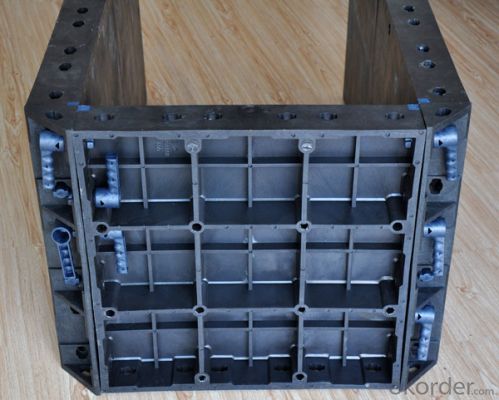 All-Round Scaffolding System Formwork Ringlock Scaffolding System Made In China
All-Round Scaffolding System Formwork Ringlock Scaffolding System Made In China
Used Cuplock Scaffolding For Sale Formwork Scaffolding Catwalk With Great Price
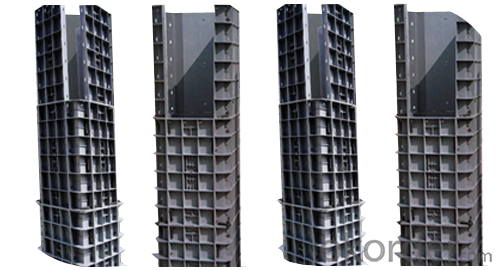
Advantage
* Good loading capacity
* Easy to assemble and dismantle
* Customized solution helps you work safe, save cost and convenient
* Excellent quality for formwork & scaffolding with wide choices
Packing
in bulk or in bundle, or as requested
Shipping
15-20 Days.
Normally small orders, it needs just 15-20 business days to the port. For goods with stock, it would be even shoter.
All-Round Scaffolding System Formwork Ringlock Scaffolding System Made In China
Other scaffolding & formwork products:
(1) Scaffolding System:
Including Ringlock Scaffolding System and accessories; Cuplock Scaffolding System and accessories; Kwikstage Scaffolding System and accessories; Haki Scaffolding System and accessories;
(2) Scaffolding Frame & Accessories:
Including Walk Through Frame Scaffolding; Ladder Frame Scaffolding; Accessories; we also can make scaffolding according to your samples or drawings.
(3) Scaffolding Couplers/Clamps
(4) Formwork System Scaffolding & Accessories
FAQ All-Round Scaffolding System Formwork Ringlock Scaffolding System Made In China
Why Us?
We are one of the Top 500 in the world, largest construction materials supplier in China. Also we are a state-owned company and respond to every customer with large and also small orders.
Excellent products with competitive prices.
Efficient services in pre and after sale.
Full energy with affluent experience team.
- Q: What are the considerations for selecting the appropriate formwork for different concrete strengths?
- When selecting the appropriate formwork for different concrete strengths, there are several considerations that need to be taken into account. Firstly, the type and size of formwork should be chosen based on the anticipated concrete strength. Different concrete strengths require different levels of support and reinforcement, so the formwork needs to be able to withstand the pressure exerted by the concrete during pouring and curing. For high-strength concrete, formwork with higher load-bearing capacities and greater rigidity may be necessary. Another consideration is the surface finish required for the final concrete structure. If a smooth and flawless finish is desired, the formwork needs to be able to provide the necessary support and stability to prevent any deformations or surface imperfections. For higher concrete strengths, the formwork should be able to resist the pressure and prevent any bulging or shifting that could result in an uneven surface. The duration of the concrete pouring and curing process is also an important factor. Different concrete strengths have varying curing times, and the formwork needs to be able to withstand the weight of the concrete for the entire duration of the curing process. This includes considering the formwork's ability to resist temperature changes and potential shrinkage or expansion of the concrete as it cures. Additionally, the availability and cost of the formwork should be taken into consideration. Some types of formwork may be more readily available or cost-effective for certain concrete strengths, so it is important to evaluate the practicality and affordability of the formwork options. Lastly, safety is a critical consideration. The formwork should be able to provide a secure and stable environment for workers during the concrete pouring and curing process. It should be able to withstand any potential stresses or pressures without compromising the safety of the construction site. In summary, when selecting the appropriate formwork for different concrete strengths, it is important to consider factors such as load-bearing capacity, surface finish requirements, curing duration, availability, cost, and safety. By carefully evaluating these considerations, a suitable formwork system can be chosen to ensure the successful construction of concrete structures with different strengths.
- Q: What is the typical lifespan of steel frame formwork?
- The typical lifespan of steel frame formwork can vary depending on several factors such as usage, maintenance, and environmental conditions. However, with proper care and maintenance, steel frame formwork can last for several years, often exceeding 10 to 15 years.
- Q: How does steel frame formwork contribute to the overall safety of construction sites?
- Steel frame formwork contributes to the overall safety of construction sites in several ways. Firstly, steel is a strong and durable material that provides stability and support to the structure being constructed. This ensures that the formwork remains intact, reducing the risk of collapse or accidents during the construction process. Additionally, steel frame formwork is designed to be easily assembled and dismantled, which allows for faster and safer construction. It eliminates the need for extensive manual labor and reduces the risk of injuries associated with traditional formwork methods. Furthermore, steel frame formwork is highly resistant to fire, corrosion, and weather conditions, which enhances the safety of construction sites. This eliminates the risk of structural failure due to external factors, ensuring the safety of workers and the longevity of the structure. Moreover, steel frame formwork provides a stable working platform for workers, reducing the risk of slips, trips, and falls. It also allows for better visibility and access to the construction site, enabling workers to perform their tasks efficiently and safely. Overall, the use of steel frame formwork in construction sites significantly contributes to the overall safety by providing stability, durability, and ease of use. It minimizes the risk of accidents, ensures the structural integrity of the building, and provides a safe working environment for construction workers.
- Q: What are the different types of accessories used in conjunction with steel frame formwork?
- Some of the different types of accessories used in conjunction with steel frame formwork include tie rods, formwork clamps, formwork nuts, formwork couplers, formwork panels, formwork corners, and formwork supports. These accessories help in ensuring proper alignment and stability of the steel frame formwork system during the concrete pouring and curing process.
- Q: What are the different components of steel frame formwork?
- The steel frame formwork typically consists of various components: 1. Panels serve as the primary element of the system, made from steel or aluminum. They are designed to be lightweight yet sturdy, coming in different sizes, shapes, and thicknesses based on the required strength and load-bearing capacity. 2. To ensure a tight and secure formwork system, connecting pins made of steel are used to join the panels together. These pins are inserted through pre-drilled holes in the panels, providing stability and preventing any movement or displacement during concrete pouring. 3. Wedges, usually made of steel or plastic, are used in conjunction with the connecting pins to further secure the formwork system. They are inserted between the panels and pins, creating a tight fit and preventing any gaps or spaces that could lead to leakage or uneven concrete placement. 4. Props are vertical support devices made of steel, providing additional strength and stability to the formwork system. They can be adjusted in height, allowing flexibility in formwork installation. Props play a crucial role in supporting the weight of the concrete and formwork, ensuring a safe and reliable construction process. 5. Braces, made of steel, are horizontal or diagonal supports used to reinforce the formwork system and prevent any buckling or bending of the panels. They are installed at regular intervals, providing additional stability and rigidity to the formwork structure. 6. Various accessories, including clamps, ties, and brackets, may also be included in the steel frame formwork system. These accessories secure the formwork system to the existing structure, ensure accurate panel alignment, and provide additional reinforcement where necessary. Collectively, these components form a robust and reliable system for concrete construction. The combination of panels, connecting pins, wedges, props, braces, and accessories guarantees a strong and stable formwork structure capable of withstanding the pressures and forces exerted during the concrete pouring process.
- Q: What is the cost of steel frame formwork compared to other types of formwork?
- The cost of steel frame formwork can vary depending on various factors such as the size and complexity of the project, the location, and the specific requirements. However, in general, steel frame formwork tends to be more expensive compared to other types of formwork materials such as wood or aluminum. The higher cost of steel frame formwork is primarily due to the durability and strength of steel as a material. Steel is known for its robustness and ability to withstand high loads and pressures, making it a preferred choice for heavy-duty construction projects. Its long lifespan and resistance to wear and tear also contribute to its higher price point. Furthermore, steel frame formwork offers several advantages over other types of formwork, including better dimensional accuracy, increased stability, and enhanced reusability. These benefits, coupled with the superior strength of steel, make it a popular choice for large-scale construction projects that require a high level of precision and durability. While the initial investment in steel frame formwork may be higher, it often proves to be a cost-effective choice in the long run due to its extended lifespan and reusability. By eliminating the need for frequent replacements or repairs, steel frame formwork can help reduce overall project costs and improve efficiency. It is important to note that the cost of formwork is just one aspect to consider when choosing the most suitable option for a construction project. Factors such as project requirements, timeline, and complexity should also be taken into account to make an informed decision. Consulting with construction experts and evaluating the specific needs of the project can help determine the most cost-effective formwork solution.
- Q: What are the different types of finishes available with steel frame formwork?
- There are several different types of finishes available with steel frame formwork, each offering unique benefits and aesthetic appeal. 1. Smooth Finish: This is the most common type of finish and is achieved by using high-quality steel forms. It provides a sleek and polished surface, ideal for projects where a clean and professional appearance is desired. Smooth finishes are often used in commercial buildings, bridges, and infrastructure projects. 2. Textured Finish: Textured finishes are achieved by using specialized form liners or by applying coatings to the steel forms. This type of finish adds texture and pattern to the concrete surface, creating a visually appealing and unique look. Textured finishes are commonly used in architectural projects, such as facades, walls, and decorative panels. 3. Exposed Aggregate Finish: Exposed aggregate finishes are achieved by using special form liners or by exposing the aggregate in the concrete surface through mechanical means, such as sandblasting or water jetting. This type of finish reveals the natural beauty of the aggregates, resulting in a decorative and visually interesting surface. Exposed aggregate finishes are often used in sidewalks, driveways, and other outdoor applications. 4. Stamped Finish: Stamped finishes are achieved by using textured form liners or by stamping the concrete surface with specialized tools. This type of finish replicates the appearance of natural materials, such as brick, stone, or wood. Stamped finishes are commonly used in residential projects, such as patios, walkways, and pool decks, to achieve a high-end and decorative look. 5. Polished Finish: Polished finishes are achieved by grinding and polishing the concrete surface to a smooth and reflective shine. This type of finish is not applied directly to the steel forms but is achieved after the concrete has cured. Polished finishes are often used in commercial and industrial projects, such as retail stores, warehouses, and showrooms, as they provide a durable and low-maintenance surface. Overall, the choice of finish for steel frame formwork depends on the project requirements, design aesthetics, and desired level of durability and maintenance. Consulting with a professional contractor or formwork supplier can help determine the most suitable finish for a specific project.
- Q: How does steel frame formwork contribute to the overall energy efficiency of a concrete structure?
- Steel frame formwork can contribute to the overall energy efficiency of a concrete structure in several ways. Firstly, steel is a highly durable and long-lasting material. This means that steel frame formwork can be reused multiple times, reducing the need for new formwork materials for each concrete pour. By minimizing the amount of formwork needed, steel frame formwork reduces the energy required for manufacturing and transporting new formwork components, thereby reducing the overall embodied energy of the structure. Additionally, steel frame formwork provides excellent thermal insulation properties. It helps to reduce heat loss and gain, thereby improving the energy efficiency of the concrete structure. By minimizing thermal bridging, steel frame formwork can contribute to the overall insulation performance of the building envelope, reducing the need for additional insulation materials and decreasing the energy required for heating and cooling the structure. Moreover, steel frame formwork allows for precise and accurate concrete placement. This ensures that the concrete structure is constructed with minimal wastage, reducing the amount of energy required for concrete production and transport. By optimizing the use of concrete, steel frame formwork contributes to the overall energy efficiency of the structure. Furthermore, steel frame formwork can facilitate the incorporation of energy-efficient design features into the concrete structure. For example, it enables the integration of voids and recesses for installing insulation materials, ventilation systems, or other energy-saving components. By providing the necessary flexibility in design, steel frame formwork allows for the implementation of energy-efficient strategies, such as the use of renewable energy sources or passive design techniques. In conclusion, steel frame formwork contributes to the overall energy efficiency of a concrete structure by reducing the embodied energy of the construction materials, improving thermal insulation, minimizing concrete wastage, and enabling the integration of energy-saving design features. Its durability, precision, and flexibility make it a sustainable choice that helps to optimize the energy performance of the building.
- Q: Can steel frame formwork be used for multi-story buildings?
- Yes, steel frame formwork can be used for multi-story buildings. Steel frame formwork is a versatile and durable construction technique that offers several advantages for multi-story buildings. Firstly, steel frame formwork provides strength and stability to support the weight of multiple floors. It can withstand the high loads and pressures generated by the different construction stages and the weight of the building itself. This makes it suitable for constructing tall buildings with multiple stories. Secondly, steel frame formwork allows for efficient and precise construction. The modular nature of steel formwork systems enables quick assembly and disassembly, saving time and labor costs. It also allows for flexibility in adapting to different floor layouts and structural designs. Additionally, steel frame formwork provides a smooth and even finish to the concrete structure, ensuring high-quality construction. The steel panels are typically coated or treated to prevent rust and corrosion, ensuring the longevity and durability of the formwork system. Furthermore, steel frame formwork can be reused multiple times, making it a cost-effective choice for multi-story buildings. Unlike traditional timber formwork, steel formwork can be easily dismantled, cleaned, and reused for future projects, reducing waste and saving resources. In conclusion, steel frame formwork is a suitable and efficient choice for multi-story buildings. Its strength, durability, versatility, and cost-effectiveness make it an ideal construction technique for constructing tall structures with multiple floors.
- Q: How does steel frame formwork contribute to the overall fire resistance of a structure?
- Steel frame formwork contributes to the overall fire resistance of a structure in several ways. Firstly, steel is known for its high melting point and excellent heat resistance. This means that it can withstand high temperatures for longer periods of time before it starts to lose its structural integrity. In the event of a fire, the steel frame formwork acts as a barrier, protecting the structure from the direct heat of the flames and preventing the spread of fire to other parts of the building. Additionally, steel frame formwork has the ability to retain its strength even at elevated temperatures. This is crucial in maintaining the structural stability of the building during a fire. Unlike other construction materials, such as wood or concrete, steel does not weaken or lose its load-bearing capacity when exposed to high temperatures. This ensures that the structure remains intact and reduces the risk of collapse. Moreover, steel is non-combustible, meaning it does not ignite or contribute fuel to a fire. This characteristic further enhances the fire resistance of the structure as it helps to contain the fire within a specific area and prevents it from spreading to other parts of the building. By confining the fire to a limited space, steel frame formwork allows for easier and safer evacuation of occupants and provides more time for firefighting efforts. Furthermore, steel frame formwork is often used in conjunction with fire-resistant materials, such as fire-resistant insulation and fire-rated coatings. These additional measures enhance the fire resistance of the structure by providing an extra layer of protection against the heat and flames. The combination of steel frame formwork and fire-resistant materials creates a robust fire-resistant system that significantly improves the overall fire safety of the building. In conclusion, steel frame formwork contributes to the overall fire resistance of a structure by providing a strong and heat-resistant barrier, retaining its load-bearing capacity at high temperatures, being non-combustible, and working in tandem with fire-resistant materials. By incorporating steel frame formwork into the construction process, the risk of fire-related damage and the potential for loss of life can be greatly reduced.
Send your message to us
All-Round Scaffolding System Formwork Ringlock Scaffolding System Made In China
- Loading Port:
- Tianjin
- Payment Terms:
- TT OR LC
- Min Order Qty:
- 10000 set
- Supply Capability:
- 50000 set/month
OKorder Service Pledge
OKorder Financial Service
Similar products
Hot products
Hot Searches
